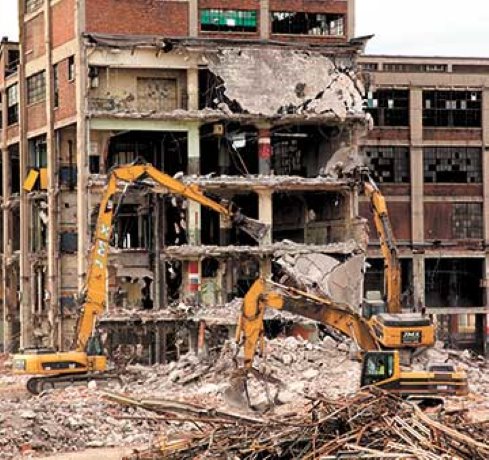The National Demolition Association (NDA) has released the fifth edition of its Demolition Safety Manual with a fresh eye on topics that include the use of advanced high-reach hydraulic equipment and a new slate of hazardous materials likely to be encountered on projects. The last major edition of the manual was published in 2008 by the trade organization, which represents about 800 U.S. and Canadian demolition contractors.
Approximately 80 pages worth of new content and revisions have been studied and recommended by the NDA’s safety committee and other industry safety leaders. While the manual is keyed to regulations under the US Occupational Safety and Health Administration (OSHA) it acts as a standalone guide to demolition project safety.
“The manual has been used by construction and demolition associations ranging from the UK to Greece and Japan and has been translated into multiple languages including Spanish, French and Japanese,” says Michael R. Taylor, executive director of the NDA.
Taylor recalls working on the first NDA safety manual during the tail end of the Jimmy Carter Administration.
“When we published in 1981, a lot of the contractors were still using chains and iron wrecking balls which you could buy from a foundry for a dollar a pound,” he recalls.
The first draft of the manual included information on three hazardous materials: asbestos, polychlorinated biphenyls and lead.
“As with the current edition, development of the manual was supported by a grant from OSHA,” says Taylor. “However, when we wanted to include a section on lead exposure, there were no existing regulations under OSHA that covered construction or demolition exposure to lead—it was only covered as an industrial material, so we couldn’t publish any OSHA-sanctioned guidelines for lead exposure.”
The manual eventually grew to cover a range of 30 hazardous materials—including lead. The latest four additions are arsenic, cadmium, silica and hexavalent chromium.
“A demolition company isn’t likely to run into these materials tearing down a strip mall outside Calgary,” says Taylor. “However, you might find them in some heavy-duty industrial plants.”
As important as hazardous materials is the new equipment that dominates current demolition projects.
“The hydraulic revolution is still in full swing,” says Taylor. “High-reach excavators that reach 20 or 25 storeys and increasingly powerful booms continue to enter the market, as do more versatile and powerful attachments, such as a grapples, shears and hammers. Topics such as quick coupler safety and the safe use of high-reach long boom arms are all referenced in the manual.”
A Canadian version of the manual was published in 2008, with support from the Ontario Ministry of Labour and the former Construction Safety Association of Ontario.
“However, after a meeting with a group of Ontario-based NDA members and some Canadian construction safety people it was decided not to attempt to develop a Canadian-specific manual,” says Taylor. “Each province’s safety rules vary so greatly from P.E.I. to B.C. that it would be almost impossible to include them in one volume, so the decision was made to develop a generic demolition safety manual.”
Individual countries and provinces are invited to include their unique demolition safety rules and regulations in a supplement to the manual.
The manual is offered on DVD in digital formats only. It can be read on both desktop computers and mobile devices and is fully searchable. The manual will also soon launch in an online searchable format. While it’s free to members, non-members can purchase it online for $100 at the NDA web site at www.demolitionassociation.com.
“If you follow the safety procedures in this manual, there’s a good chance you and your workers will still be in business five years from now,” says Taylor.



Recent Comments
comments for this post are closed